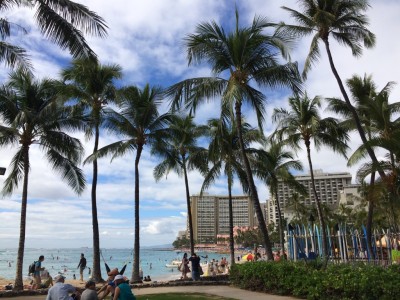 Sitting on a Hawaiian Airlines jet looking out at the azure Pacific. Israel Kamakawiwo’ole’s “Somewhere Over the Rainbow”– which first caught my attention further across the Pacific, in Sydney, Australia on my big world trip –plays on my headphones. My at-long-last first-ever journey to the Hawaiian islands, a holiday gift from my partner Mathew, is winding to a close.
Sitting on a Hawaiian Airlines jet looking out at the azure Pacific. Israel Kamakawiwo’ole’s “Somewhere Over the Rainbow”– which first caught my attention further across the Pacific, in Sydney, Australia on my big world trip –plays on my headphones. My at-long-last first-ever journey to the Hawaiian islands, a holiday gift from my partner Mathew, is winding to a close.
Hawaiian tropes run redolent through modern American culture, finding their fullest expression in the Hawaiian Renaissance of my youth, and continuing to today: consider Wikipedia, Akamai, luau, lanai, and countless other bits of Hawaiian terminology that have made their way into the vernacular. I’ve long been curious to check out these islands plopped in the middle of the Pacific… though also held that bit of trepidation as to what mass tourism might have done to these otherwise-isolated locales.
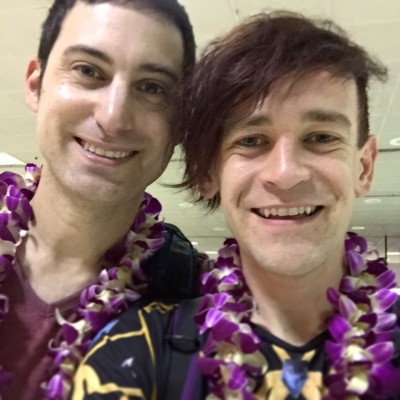 Stephen Colbert’s jokes about Hawaii not being part of America holds one immediately-apparent benefit: with the island chain almost as distant from California as is the East Coast, flights to Hawaii are a serious affair: our Hawaiian Airlines widebody service had the feel of an international flight. Mathew further bumped it up, springing for a lei greeting on landing. I’d always thought of these floral necklaces as tacky plastic affairs, but ours were gorgeously done-up strands of fragrant flowers that stayed fresh throughout our visit.
Stephen Colbert’s jokes about Hawaii not being part of America holds one immediately-apparent benefit: with the island chain almost as distant from California as is the East Coast, flights to Hawaii are a serious affair: our Hawaiian Airlines widebody service had the feel of an international flight. Mathew further bumped it up, springing for a lei greeting on landing. I’d always thought of these floral necklaces as tacky plastic affairs, but ours were gorgeously done-up strands of fragrant flowers that stayed fresh throughout our visit.
Since this was my “starter” trip to the islands, Mathew opted to bring me to O’ahu and stay in Waikiki. Once a verdant marshland and longboard surf spot of Hawaiian royalty, Waikiki is now a bit of a Miami Beach on the Pacific – dense, crowded, filled with high-rise hotels. One interesting wrinkle: with the influx of Asian tourists, Waikiki is positively crawling with noodle joints, sushi shops, and Korean barbecue spots reminiscent of my Asian travels of years past. One of these little spots made for a tasty lunch while we waited for our hotel room to be ready.
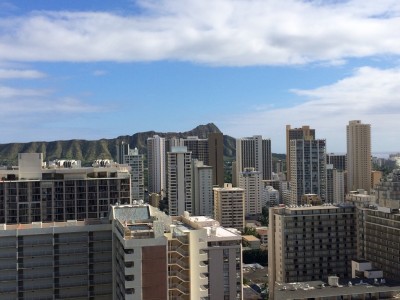 As this was a holiday gift, Mathew sought out upgraded experiences throughout. He’d booked us into a luxurious condo-hotel, Aqua Skyline at Island Colony, that claimed to be the tallest accommodations in the area. Not advertised was its 1970s-era structure that had been only minimally upgraded, accompanied by indifferent, apartment-house levels of service. The forty-plus story building is serviced by four elevators that were crammed, crowded, and frequently out of service during our stay; while the room did indeed offer a stellar view of town, it also featured spottily-cleaned facilities, rundown corridors, and other artifacts of mediocre accommodations. Heck, we’d both been in better-run youth hostels and budget chain motels. After much frustration with intransigent staffers, Mathew finally was able to voice his complaints to a manager who tried to make good… but overall I was reminded that, even in spots with robust tourist infrastructure, patches of weakness can and do exist.
As this was a holiday gift, Mathew sought out upgraded experiences throughout. He’d booked us into a luxurious condo-hotel, Aqua Skyline at Island Colony, that claimed to be the tallest accommodations in the area. Not advertised was its 1970s-era structure that had been only minimally upgraded, accompanied by indifferent, apartment-house levels of service. The forty-plus story building is serviced by four elevators that were crammed, crowded, and frequently out of service during our stay; while the room did indeed offer a stellar view of town, it also featured spottily-cleaned facilities, rundown corridors, and other artifacts of mediocre accommodations. Heck, we’d both been in better-run youth hostels and budget chain motels. After much frustration with intransigent staffers, Mathew finally was able to voice his complaints to a manager who tried to make good… but overall I was reminded that, even in spots with robust tourist infrastructure, patches of weakness can and do exist.
Fortunately, the next day’s excursion more than made up for it: part of Mathew’s motivation for taking me to O’ahu was for its highly popular – if less high-profile than, say, Pearl Harbor – attraction on its northeast coast: the Polynesian Cultural Center.
An unlikely-seeming initiative of the Mormon Church, the PCC’s been around for more than half a century, showcasing the history and culture of a number of Polynesian nations scattered across some 12 million miles of ocean. Part theme park, part educational foundation – its employees are local college students, hailing from the various islands, who earn their tuition by working at the center. Say what you want about missionaries and their effects on nonwhite cultures throughout history; this spot at least seeks to redress some of that past by honoring and celebrating indigenous practices and rituals.
We were picked up in a cushy minibus by a friendly, older, part-Hawaiian driver. He offered up bits of Hawaiian history and trivia as he drove the forty-some miles north through the Koʻolau Mountain Range and up along O’ahu’s eastern coast.
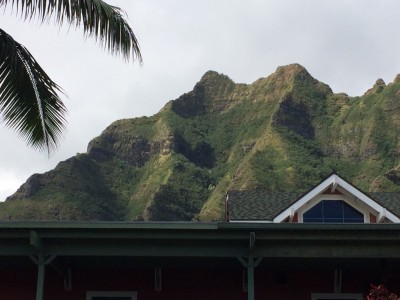 I’ve long ruminated about the missing piece in mainland America’s warm-weather geographical puzzle: my adopted homeland’s incredibly diverse landscapes offer up both dry, California-Mediterranean mountainscapes and Floridian pancake-flat tropics – but never do the twain meet on the mainland. The drive north from Waikiki to Laie, however, revealed for me at last that puzzle piece: glorious, rain-drenched, craggy volcanic peaks touch the clouds as they tumble verdantly toward palm-lined coasts. O’ahu is often associated with the tourist tangle of Waikiki and the military presence of Pearl Harbor… but little is mentioned about its stunning geographic beauty.
I’ve long ruminated about the missing piece in mainland America’s warm-weather geographical puzzle: my adopted homeland’s incredibly diverse landscapes offer up both dry, California-Mediterranean mountainscapes and Floridian pancake-flat tropics – but never do the twain meet on the mainland. The drive north from Waikiki to Laie, however, revealed for me at last that puzzle piece: glorious, rain-drenched, craggy volcanic peaks touch the clouds as they tumble verdantly toward palm-lined coasts. O’ahu is often associated with the tourist tangle of Waikiki and the military presence of Pearl Harbor… but little is mentioned about its stunning geographic beauty.
“What percentage of Hawaii is ethnically native?” I asked Fred, our driver. While the fully-indigenous number only about five percent, he said – still a substantially larger proportion than, say, Native Americans on the mainland – those of mixed heritage (Fred himself is part Portuguese) number many more. With so many locales, towns, streets, and geographic formations retaining their native names, the indigenous presence on these islands gives the place a feel unlike anywhere else I’ve been in the U.S. mainland.
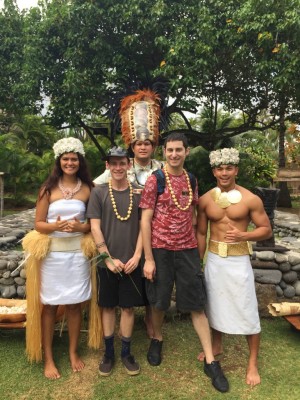 As part of our “Super Ambassador” package, we were met by our private guide for the day. Stop – “like stop sign!” he exclaimed – was a chatty, enthusiastic Thai native who walked us through the various island villages. Unlike, say, a Disney theme park, the PCC adds an up-close and interactive dimension to the mix of island-culture spectacles and exhibits: we practiced spear throwing (Mathew kicked ass at that) hula dancing (arguably one of my more ridiculous attempts to look graceful) palm-leaf weaving (I was better at that) and making a fire with only two pieces of wood (I got the thing to smoke!) All is presided over by the Center’s charismatic, friendly, comely students. Heck, I even got to practice my French with the Tahitians.
As part of our “Super Ambassador” package, we were met by our private guide for the day. Stop – “like stop sign!” he exclaimed – was a chatty, enthusiastic Thai native who walked us through the various island villages. Unlike, say, a Disney theme park, the PCC adds an up-close and interactive dimension to the mix of island-culture spectacles and exhibits: we practiced spear throwing (Mathew kicked ass at that) hula dancing (arguably one of my more ridiculous attempts to look graceful) palm-leaf weaving (I was better at that) and making a fire with only two pieces of wood (I got the thing to smoke!) All is presided over by the Center’s charismatic, friendly, comely students. Heck, I even got to practice my French with the Tahitians.
What captivated me most, however, was a nondescript wooden hull resting amid the huts: an early Polynesian outrigger canoe. It was these vessels, the original speedboats to Polynesia, that carried the ancestors of these youngsters thousands of miles across open ocean to these far-flung islands at the edge of creation.
The Center’s marquee attraction, however, comes after dark: going beyond the ceremonies one finds at traditional Hawaiian luaus, the PCC’s nightly show, “Ha: Breath of Life,” is a Vegas-level tour-de-force held in a capacious, outdoor semicircular theatre. Chronicling the rhythms of life of a traditional Polynesian boy who grows to manhood, the show features masterfully-choreographed performances, capped by a dazzling fire-twirling number at the show’s finale that blew away what I’d seen in years past on beaches in Southeast Asia. Between that and the experiential IMAX film we’d seen showcasing the Hawaiian islands’ geography, I left moved and astounded by this glorious part of the world and its peoples’ mastery of its riches.
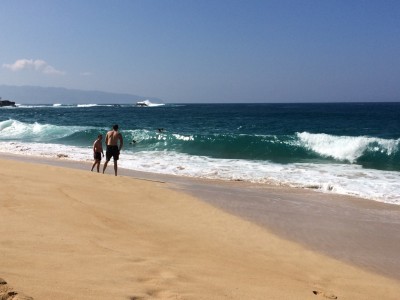 I’d gone for a dunk in Waikiki Beach on our first day, but that only whetted my appetite for more Hawaiian surf. While O’ahu’s south- and east-facing beaches feature modest waves, the bodysurfer in me – egged on by a reco from Stop the day before – opted to go for the gold: we snagged a rental car, traversed the island and its pineapple plantations en route to its famed North Shore. Arriving at beautiful Waimea Bay, we beheld them: fat barrel rolls at the shorebreak. Families splashed and played amid stern admonishments from surly lifeguards that “this is a beach for professionals with many years of experience!” I (mostly) played it safe, catching swims during lulls between the big waves, but also did a bit of bodysurfing on some of the bigger swells. The lifeguards weren’t kidding: this spot (in winter at least, when the big waves come) took most of my skill as a Bronze Medallion holder (Canada’s first-level lifeguarding course that I completed in high school) to avoid getting crushed by massive wave energy.
I’d gone for a dunk in Waikiki Beach on our first day, but that only whetted my appetite for more Hawaiian surf. While O’ahu’s south- and east-facing beaches feature modest waves, the bodysurfer in me – egged on by a reco from Stop the day before – opted to go for the gold: we snagged a rental car, traversed the island and its pineapple plantations en route to its famed North Shore. Arriving at beautiful Waimea Bay, we beheld them: fat barrel rolls at the shorebreak. Families splashed and played amid stern admonishments from surly lifeguards that “this is a beach for professionals with many years of experience!” I (mostly) played it safe, catching swims during lulls between the big waves, but also did a bit of bodysurfing on some of the bigger swells. The lifeguards weren’t kidding: this spot (in winter at least, when the big waves come) took most of my skill as a Bronze Medallion holder (Canada’s first-level lifeguarding course that I completed in high school) to avoid getting crushed by massive wave energy.
Tha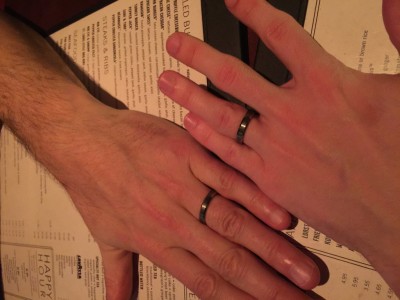 t evening, our last in Waikiki, saw us do an impromptu bit of shopping while waiting for a table for dinner. Mathew and I stopped in at a jewelry store, where a friendly older Asian lady showed us an array of tungsten rings. The price was right and the look was good, so we did it: having made our domestic partnership official earlier this year, we now have some (tasteful) bling to mark the occasion.
t evening, our last in Waikiki, saw us do an impromptu bit of shopping while waiting for a table for dinner. Mathew and I stopped in at a jewelry store, where a friendly older Asian lady showed us an array of tungsten rings. The price was right and the look was good, so we did it: having made our domestic partnership official earlier this year, we now have some (tasteful) bling to mark the occasion.
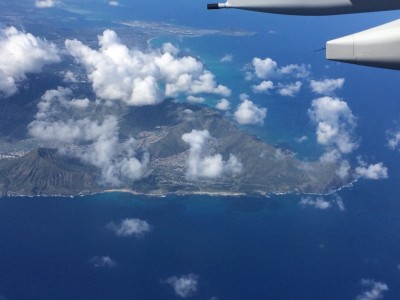 As our aerial speedboat from Polynesia lifted off from Honolulu Airport next afternoon, I beheld the dense thicket of Waikiki skyscrapers abutting the jagged, volcanic Diamond Head crater. As the elegant neighborhood of Kahala and the beach towns of eastern O’ahu faded from view, I felt an odd kinship with the people of these islands; after all, they descend from the truest of world travelers, intrepid outrigger explorers who braved Earth’s largest ocean to settle in their beautiful little corner of the known world.
As our aerial speedboat from Polynesia lifted off from Honolulu Airport next afternoon, I beheld the dense thicket of Waikiki skyscrapers abutting the jagged, volcanic Diamond Head crater. As the elegant neighborhood of Kahala and the beach towns of eastern O’ahu faded from view, I felt an odd kinship with the people of these islands; after all, they descend from the truest of world travelers, intrepid outrigger explorers who braved Earth’s largest ocean to settle in their beautiful little corner of the known world.
Tags: 2 Comments





New Blog Post: Speedboat to Polynesia http://t.co/mt4ZgAOEuR
RT @davidjed: New Blog Post: Speedboat to Polynesia http://t.co/mt4ZgAOEuR